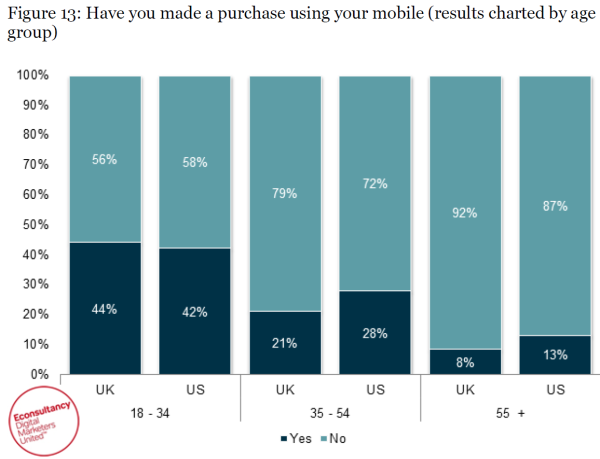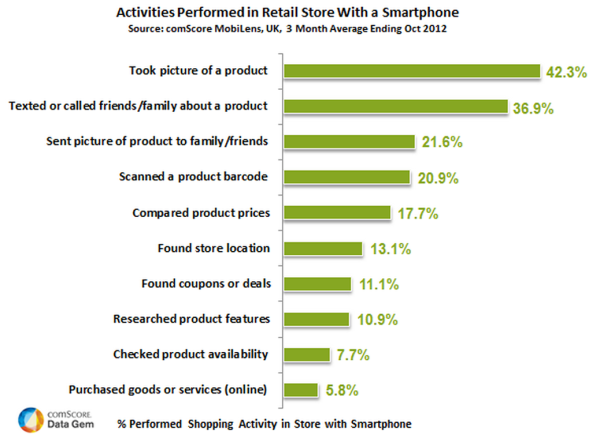3 Major Tablet & Smartphone Search Opportunities For Multinational Websites
Looking back at 2012 statistics for smartphone usage & tablet sales figures paints a picture of significant multinational SEO opportunity in 2013. Here are three key SEO opportunities for 2013 and how to take advantage of them.
Looking back at 2012 statistics for smartphone usage and tablet sales figures paints a picture of significant multinational SEO opportunity in the coming months. Here are three key SEO opportunities for 2013 and how to take advantage of them.
1. Majority Of 18-34 Demographic Will Use Their Phones To Make A Purchase In 2013
In August 2012, eConsultancy surveyed this metric, and found 42% in the US and 44% in the UK had made a purchase with their mobile.

For 35-54 year olds, the numbers drop off to 28% and 21%, respectively, and for 55+ ages, 13% and 8%. This significant drop off for older generations results in a much lower overall purchase metric of 28% and 25% for the US & UK, respectively, although this is still over double the 2011 figure.
As highly developed markets in both per-capita income and online saturation, the US & UK are bellweather markets for the rest of the developed and developing world. So, while we can say with some accuracy that 2012 was finally the year of the mobile for e-commerce, the reality is 2013 will be the breakthrough year in terms of mobile’s importance to to full retail mix for most markets.
This means that well-optimised mobile sites — and, for optimal SEO, that means responsive designs using the same URL architecture as the desktop and tablet sites — will deliver significant revenue gains for their brands.
And of course, responsive designs, in addition to preferential treatment from Google, will also allow brands with existing mobile-only URLs to consolidate via 301s and compound their domain SEO authority for stronger desktop performance: a major win-win scenario.
2. Catering To In-Store Mobile Activity Will Reap Major Dividends In 2013
In the tail end of December, comScore released research showed that in the teeth of Christmas shopping through the last quarter of 2012, 44% of UK smartphone users performed at least one shopping activity while within a physical retail store.
The stand out items were: taking a picture of the product, texting/calling friends about the product, or sending the product picture to friends; and this has taken most of the headlines when discussing the data. But for me, the most interesting aspect is the price comparison and competitive search performance openings available in the other common behaviours.
Research indicated 20.9% scanned a barcode, 17.7% compared product prices, 11.1% found coupons of deals, 7.7% checked availability, and (only!) 5.8% purchased online instead of making a physical purchase in the store.
All of these items provide opportunity for smartphone-optimised SEO or PPC campaigns to capture a sale from a customer already quite far down the purchase funnel, likely giving very high purchase conversion rates to the captured traffic.
A key strategy opportunity would be using PPC ad extensions — especially call extensions, sitelink extensions featuring offers, and location extensions — to target these specific user behaviours in your competitors’ stores globally wherever they have bricks and mortar locations (each target city can, of course, be isolated with location targeting in your ad campaign).
3. Brands Are Facing A Tsunami Of Tablet Traffic In 2013
Adobe released a research paper (pdf) in July 2012, covering tablet sales and traffic trends to 325 brands across North America, Western Europe, and Asia-Pacific. The headline numbers are:
- Tablet website share of visit growth has been 10x faster than equivalent smartphone growth in its first two years on the scene, and last year saw a 300% share growth.
- This growth suggests tablets will exceed smartphone traffic in 2013, and reach 10% of total traffic in early 2014
In addition, for the retail vertical, tablet conversion rates are 3x more ‘effective’ than smartphones, which demonstrates the value of their increased screen size and different usage patterns (in another study, this time by InMobi, 72% of tablet owners used their device while watching TV, and more than 50% used their table to access rich media content).
Also in the inMobi study, the preferred device for shopping for tablet owners was their tablet device by 46% vs. 41% for their desktop machines. So, given tablet sales, the dominant trend online is the major uptick in importance of tablet site experience.
Given that targeting improved smartphone experience, alongside improved tablet experience, this is not a technical, but rather a design and usability challenge, (it’s simply a case of targeting media queries to each device type supported with JavaScript user-agent detection for belt-and-braces implementation), tablet conversion should be right at the very top of any multinational webmaster’s priority list for 2013.
Contributing authors are invited to create content for Search Engine Land and are chosen for their expertise and contribution to the search community. Our contributors work under the oversight of the editorial staff and contributions are checked for quality and relevance to our readers. The opinions they express are their own.
Related stories
New on Search Engine Land

